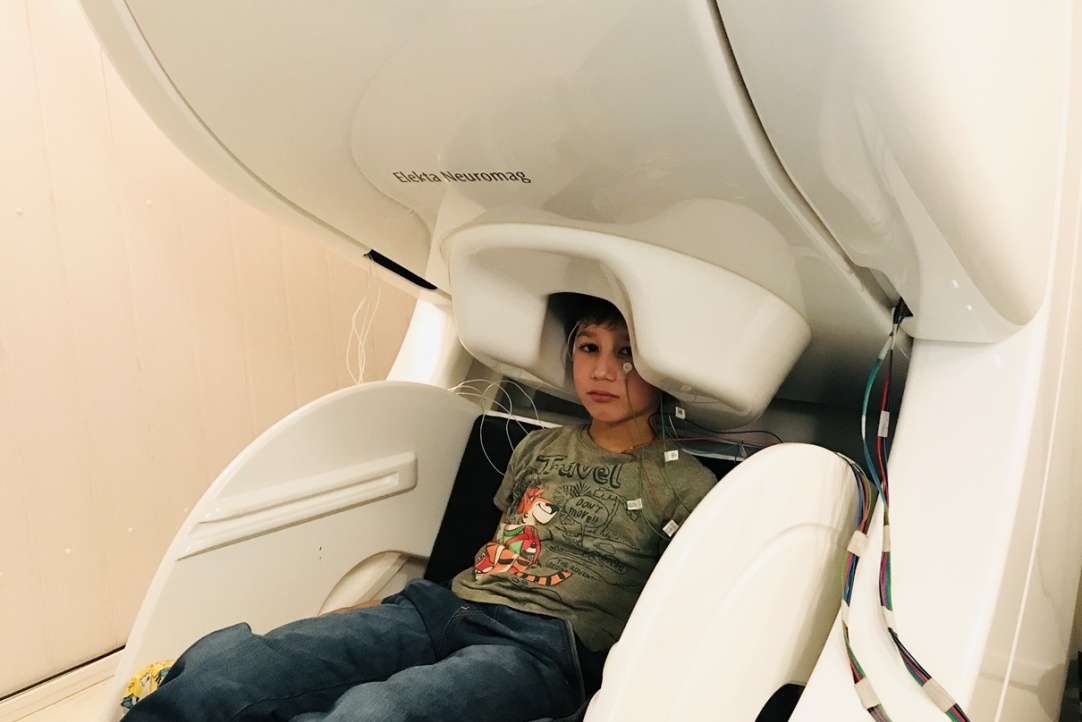HSE Researchers Identified the Age-Related Changes in Gamma-Band Oscillations in Auditory Cortex in Children

Researchers from the HSE Center for Language and Brain have identified previously unknown age-related changes in brain activity during the perception of auditory information in a group of children aged 7–12 years. The researchers used magnetoencephalography (MEG), an ultra-precise method of brain activity recording. The results obtained can be used to explore the impairments in language comprehension in children with autism. The study was published in the Human Brain Mapping.
Neurons are brain cells that communicate with each other via electrical signals. It is known that while perceiving and processing information (including acoustic information), not only the total electrical activity of neurons is significant, but also the rhythmic activity of neuron groups in different frequency ranges. Cortical gamma-band oscillations are a type of rhythmic brain activity that play a significant role in perception. Gamma rhythms are oscillations in the human brain with frequencies from 30 to 150 Hz.
Previous studies reported difficulties detecting a gamma response in young children. Scientists attribute this to the fact that this type of brain activity is associated with the inhibitory system, which matures by puberty and, as a result, the power of gamma oscillations increase with age by early puberty in children. Moreover, gamma rhythms reflect the balance between the neural excitation and inhibition in the brain, so the age-related changes in gamma power indicate the age-related changes of this balance.
Researchers from the HSE Center for Language and Brain investigated the age-related changes in the activity of gamma oscillations in the auditory cortex in 30 typically-developing primary school children (7–12 years old). The researchers used the classical Auditory Steady-State Response paradigm, presenting amplitude-modulated tones at the 40 Hz range. This paradigm enables the recording of the rhythmic activity of neurons in the auditory cortex at a frequency of 40 Hz (i.e., gamma rhythms). To record brain activity the researchers used a unique method of magnetoencephalography (MEG), which makes it possible to record the total activity of neurons in good temporal and spatial resolutions. In other words, scientists can identify how the signal flows in millisecond resolution and determine the localisation of the source of activity in the cerebral cortex.
The results demonstrated that the power of gamma oscillations in the auditory cortex changed with age: the power was higher in older children than in younger ones. In addition, the researchers have shown for the first time that the cortical localization of this activity can also change with age.
In older children, the source was located more posterior in the primary auditory cortex than in younger ones. Moreover, the researchers demonstrated for the first time that the second type of activity (the total neuromagnetic response to an auditory stimulus) in the same part of the brain also changed with age: the amplitude decreased in older children.
Finally, the results showed that the two types of brain activity were related to each other: the higher the power of rhythmic activity in the gamma range, the lower the amplitude of the total magnetic response to the stimulus. The researchers believe that all these effects are associated with age-related changes in the balance between excitation and inhibition.

Vardan Arutiunian, author of the article and junior research fellow at the HSE Center for Language and Brain
‘These age-related changes in different types of activity may be parts of the same developmental mechanism in the auditory cortex. We think that it is important to understand all these mechanisms, since in the future it can contribute to the study of auditory perception in children with atypical development. For example, a large number of studies have revealed atypical functioning of gamma oscillations in children with autism. This is likely to be one of the neurophysiological mechanisms of impairments in language comprehension in such children.’
Vardan Arutiunian
See also:
HSE University Researchers Track Language Abilities of Russian Children with ASD
Researchers from the HSE Center for Language and Brain have, for the first time, described the language abilities of Russian children with Autism Spectrum Disorder (ASD) at all linguistic levels (e.g., phonology, lexicon, morphosyntax, and discourse), using a language test that takes into account the psycholinguistic variables most relevant for Russians. The study was published in Journal of Autism and Developmental Disorders.
Brain Activity Can Reveal the Severity of Autistic Traits
A team of researchers from Russia and Israel applied a new algorithm to classify the severity of autistic personality traits by studying subjects’ brain activity. The article ‘Brief Report: Classification of Autistic Traits According to Brain Activity Recoded by fNIRS Using ε-Complexity Coefficients’ is published in the Journal of Autism and Developmental Disorders.
Complex Phonological Tests Are Useful for Diagnosing Reading Dysfunction
HSE University researchers have confirmed that the level of phonological processing skills in children can impact their ability to master reading. Complex phonological tests are best suited to detect phonological impairment. The study was published on September 6, 2020, in the Journal of Research in Reading.


